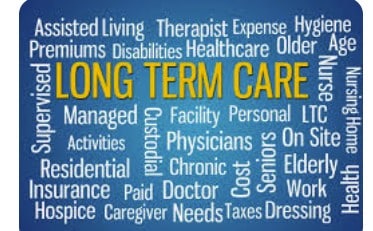Mar 07, 2025
The cost of long-term care is significant—and something most retirees will face. Here’s what to consider when deciding between self-funding or purchasing long-term care insurance.

Close to 70% of today’s 65-year-olds will require long-term care1—ranging from in-home health aides to full-fledged nursing homes—and the costs are staggering.
The median annual outlay in 2023 was $75,504 for an in-home health aide and $116,800 for a private room in a skilled nursing facility.2
With the average American requiring three years of long-term services and support during their lifetime,3 that means budgeting anywhere from $226,512 for an in-home health aide to $350,400 for a private room in a nursing home4 based on today’s prices—though your actual costs in the future could be much higher. (Those contemplating retirement communities that provide varying levels of care may need to budget even more; see “One-stop shopping.”)
“Unfortunately, long-term care is an emotional issue, and many people are uncomfortable talking about or planning for it until they need it,” says Rob Williams, managing director of financial planning and wealth management at the Schwab Center for Financial Research. “Or they may assume their loved ones will be willing and available to help, which can be a significant emotional and financial commitment.”
How, then, can you plan for the possibility of long-term care without upending your finances or your loved ones’ lives? “It’s best to talk openly and honestly about your options with everyone who might be affected,” Rob says. “For example, can you afford to pay out of pocket from savings—perhaps with some physical support from family to help keep costs down? Or would you rather have the peace of mind that long-term care insurance can provide, even if you don’t end up needing the coverage?”
Deciding on an approach starts with understanding your options and considering how they might fit into your financial plan.
Paying out of pocket
“The appeal of self-funding is you’ll pay only for the care you use, whereas with insurance you could pay premiums for years and never use the coverage,” Rob says.
The key is to plan ahead and save in ways that are tax-efficient while maintaining your flexibility, including:
- Contributing to a health savings account (HSA): Contributions to HSAs are federally tax-deductible, earnings are tax-free, and withdrawals are also tax-free if used for qualified medical expenses, including long-term care. “To maximize the value of your HSA, try to preserve its tax-free dollars for your long-term care needs by paying out of pocket for routine medical expenses you can afford to cover today,” Rob says. You must be enrolled in an eligible high-deductible health plan to make contributions to an HSA.
- Making Roth conversions: Long-term care could require you to take substantial distributions from your retirement accounts to cover your costs, potentially resulting in a significant tax bill. “Consider converting a portion of your tax-deferred savings at regular intervals to a Roth IRA without bumping yourself into the next tax bracket,” Rob says. “You’ll owe taxes on the converted amount in the year of the conversion, but any future withdrawals can be tax-free for both you and your heirs.” (If you’re still working, you also may be able to convert traditional 401(k) funds to a Roth 401(k), assuming your plan allows it.)
- Reinvesting required minimum distributions (RMDs): Reinvesting any unused RMDs in a taxable brokerage account can help put that money to work on behalf of your future long-term care. “Should you eventually need to liquidate those assets, only the gains will be taxed,” Rob says.
Paying out of pocket may offer additional tax advantages. For example, if you itemize deductions, you can write off all qualifying medical expenses—including long-term care costs—that are medically necessary and exceed 7.5% of your adjusted gross income (your total income minus certain adjustments) on an annual basis. Better yet, if you pay with tax-free dollars from a Roth account, those funds won’t be included in your taxable income, making it easier to surpass the 7.5% threshold. (Expenses paid from an HSA do not qualify as a medical deduction.)
Despite the advantages that self-funding can offer, there are risks. First and foremost, any assets invested in the market could lose value, undercutting your ability to pay for care or forcing you to sell assets at an inopportune time.
There’s also the risk that excessive care costs could eat into your living expenses. “Those who experience cognitive decline while remaining physically healthy, for instance, typically require many years of care,” says Chris Kawashima, CFP®, a director at the Schwab Center for Financial Research.
Purchasing long-term care insurance
CLICK here to continue reading



